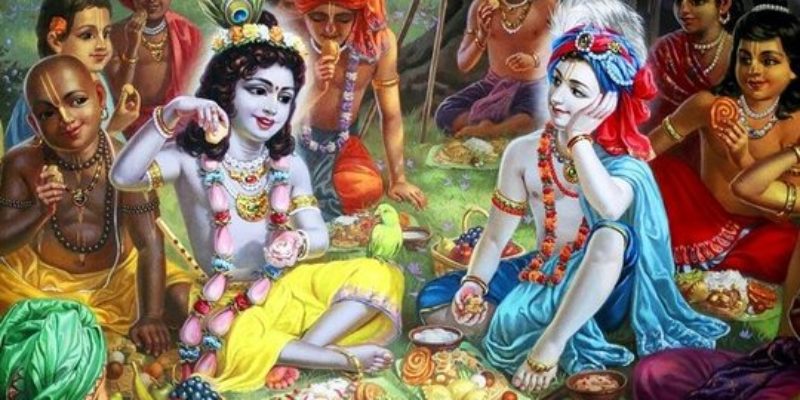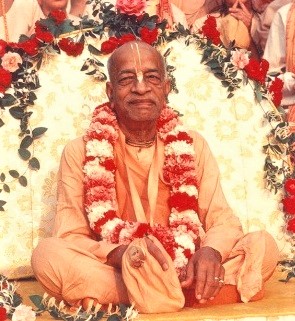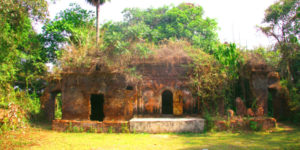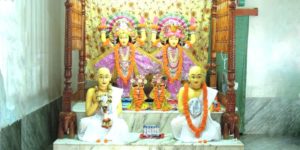Purushottam Das was the son of Sree sadashiv Kabiraj. In kåñëa-lélä he was the cowherd boy named Stoka-kåñëa. His son, Sri kanu Thakur, appeared at Sukhasagar village in the district of Nadia on a Tuesday in 1535 AD. That day was Sukla-dvitiya of the Bengali month of Ashar, and was the occasion of Ratha-yatra. Känu Öhäkura was Ujjvala Sakhä in Vraja-lélä.
tāṅra putra — mahāśaya śrī-kānu ṭhākura
yāṅra dehe rahe kṛṣṇa-premāmṛta-pūra
(Cc. Ädi-lélä 11.40)
Purushottam Das Thakur’s wife was named Jahnba. She disappeared a few days after giving birth to her son. Puruñottama became worried for his little child. Çré Nityänanda Prabhu came to Sukhsagar at that time and took away kanu Thakur to be cared for by His wife, Çré Jähnavä Devé. Observing Känu’s sincere devotion from his birth, Nityänanda Prabhu named him Çiçu-kåñëa Däsa, “the servant of Kåñëa since childhood.”
Çiçu-kåñëa Däsa visited Çré Våndävana-dhäma with Jähnavä Devé at the age of five. Seeing his nature, Çré Jéva Gosvämé and the other Vraja-väsés named him Öhäkura Kanai.
In adulthood, he moved to the village Bodhkhana in the district of Jessore (now Jashore), and from there he moved to Garbeta village in Midnapur district. Once, while taking bath in the Çilävaté River in Garbeta village, Öhäkura Kanai’s feet touched the dead body of a brähmaëa boy. He pulled the body from the water and gave chanted the mahä-mantra. The brähmaëa boy’s life returned, and Öhäkura Kanai named him Çré Räma.
Once, Öhäkura Kanai arranged the ciòä dahi festival in the village. The local brähmaëas wanted to eat mango and jackfruit in the off season, so Öhäkura Kanai went to the other bank of the Çilävaté with Çré Räma and brought back many mangoes and jackfruit, satisfying the brähmaëas.
After some days of the festival Öhäkura Kanai entered samädhi. There was no sign of life in his body, and the next day, a cowherd saw him sitting under a banyan tree in a nearby village named Dhakdia. Öhäkura Kanai accepted some curd from the cowherd and told him to go to his äçrama and take the cost of the curd from his disciples. He further said that he had been going to Våndävana to attain samädhi, and instructed the cowherd to tell his disciples to establish his samädhi there, an instruction they fulfilled. a samadhi temple there. Öhäkura Kanai was also present at the festival in Kheturé Gram.
In Bodhkhana, a very ancient deity named Pranavallabha was served. Everyone except the descendants of Öhäkura Kanai’s eldest son went to Bhajanghat in Nadia. Bodhkhana village is situated in the Jhikargacha area of Jashore district. Relics of the temple and the residence of the Gosvämés are still visible, but no descendants of the Gosvämés live there. Çréla Bhaktisiddanta Sarasvaté Öhäkura visited this Çrépät on February 21, 1925.
How to Go There
You can reach Jhikargacha by bus on the Dhaka-Benapole route. From there one has to go two-three kilometers along a narrow road to reach Bodhkhana Bazaar.
You can see other Holy Places. Click Here






